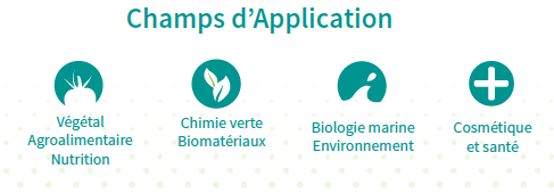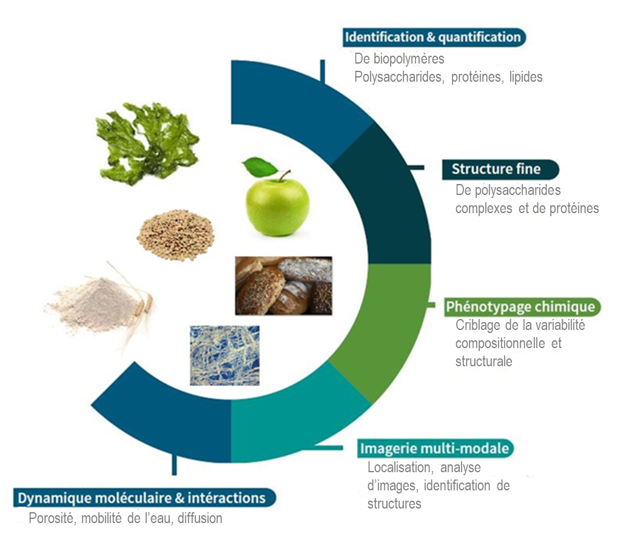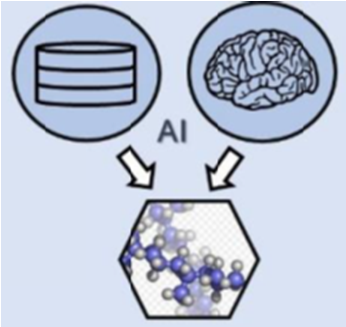BIBS – Bioresources: Imaging, Biochemistry & Structure
Description
For 20 years, the platform has supported academic and private-sector researchers in the exploration of bioresources and bioproducts, from molecule to object, for food, health and the bioeconomy. BIBS conducts innovative methodological developments and provides analytical expertise in the observation of macrostructures, characterization of biopolymers (identification, modifications), their interactions, organization and localization in systems of biological origin (plant tissues or organs, algae, bacterial media…) or synthetic origin (foods, food matrices, biofilms, composite materials…). The tools available also enable us to address dynamic parameters (diffusion, water mobility), monitor degradation or transformation activities, and screen large collections of samples on chemical and structural criteria. BIBS is also committed to developing innovative methodologies. We have state-of-the-art scientific equipment for mass spectrometry, microscopy, NMR and chemical screening. BIBS is supported by a dedicated bioinformatics group for data processing (spectra and images). The BIBS platform is part of the GIS Biogenouest, has ISO9001 certification, IBISA and INRAE accreditation, and is integrated into 3 national infrastructures (Phenome-Emphasis, PROBE and CALIS).
Location
PF BIBS, UR 1268 BIA, INRAE Nantes
Contacts
Platform manager: Sophie LE GALL
Website: https://www.bibs.inrae.fr/
Associated targeted project coordinator: Jean-François GERARD
Technical characteristics
Structural analysis
- Amazon SL Ion Trap (Bruker) (2018) (ESI-IT Technology – coupled with UPLC) modified for ion activation by accelerated helium cations (high-energy MS/MS fragmentation by CTD, Charge Transfer Dissociation) for structural characterization of oligosaccharides
- Select SERIES Cyclic IMS (Waters) (2019) (ESI-Q-IM-TOF technology – coupled with UPLC) A device equipped with a high-resolution ion mobility cell (cyclic ion mobility), for the separation of structural isomers of carbohydrates and their structural determination by MS/MS
- Q-Exactive HF (Thermo-Fisher) (2019) (ESI-Q-Orbitrap technology – coupled with nano-UPLC) for proteomics and peptidomics
- Avance III 9.4T WB high-field NMR spectrometer (Bruker) (2018) Equipped with CPMAS and HRMAS probes, static X and HX for the study of solid to soft samples
- Two Minispec Mq20 0.47T low-field NMR spectrometers (2009 and 2018) (Bruker) for density and mobility measurements of water and small solutes.
- ASE 350 extractors (Thermo-Fisher, two extractors 2010 and 2012) and automated preparation platform (Swing SL robotic workflow station, Chemspeed, 2011) for automated extraction and preparation (derivatization, hydrolysis) of polysaccharides, at medium throughput.
- TRACE GC Ultra and TRACE ISQ (Thermo-Fisher, 2011) for monosaccharide compositional analysis and bond determination.
- HPAEC, ICS 6000 (Thermo-Fisher) (2019) and ACQUITY ELSD FLUO SQD2 (Waters) (2016 and 2020) for mono/oligosaccharide structural analysis and quantification.

Imaging methods
- MALDI TOF rapifleX Tissue typer (Bruker) (2018) for high-rate-of-fire molecular imaging (10 kHz) and spatial resolution of 5-µm.
- Atomic force microscope (Bruker) coupled in Raman (Renishaw) (2013) for the observation of structures and topography at the nanoscale and measurements of elastic modulus & localized chemical composition.
- Transmission electron microscope 1230 (JEOL)(2005). Operation in cryogenic and conventional mode for the observation of structures at the nanoscale.
- Quattro S scanning electron microscope (Thermo-Fisher) (2019). Operation in environmental mode, suitable for soft and hydrated samples, transmission mode (STEM), elementary analyzer, for the observation of structures at the mesoscopic scale.
- A1R confocal laser scanning microscope (NIKON) (2009, partial renewal in 2019). Fluorescence microscopy for micrometric observation of target molecules (e.g. proteins) after marking.
- Avance III 9.4T WB High Field NMR Spectrometer (Bruker) for Micro-Imaging

Associated targeted project
